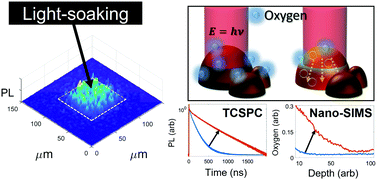Visualizing the role of photoinduced ion migration on photoluminescence in halide perovskite grains†
Abstract
Ion migration is a characteristic feature of organic–inorganic halide perovskites. Importantly, migration of ion vacancies or adsorbed external ions can be manipulated by illumination, and this light-induced ion diffusion can enhance the internal quantum efficiency by reducing the density of charge trap sites. Here, the role of oxygen and halide ions on energy dynamics is investigated by performing in situ measurements of ion diffusion from the air-perovskite interface into the bulk. By correlating temporally, spatially, and spectrally-resolved optical microscopy with high spatial resolution secondary ion mass spectroscopy, it is shown that changes in local photoluminescence are caused by light-induced ion migration with a clear grain-size dependence related to surface-area to volume ratio. As a result, the charge carrier dynamics evolve from low luminescing defect-assisted monomolecular recombination to bright bimolecular recombination under illumination. These findings unambiguously link atomic diffusion to local radiative efficiency in spatially inhomogeneous films, and provide a route to high quantum efficiency through ion distribution engineering.



 Please wait while we load your content...
Please wait while we load your content...